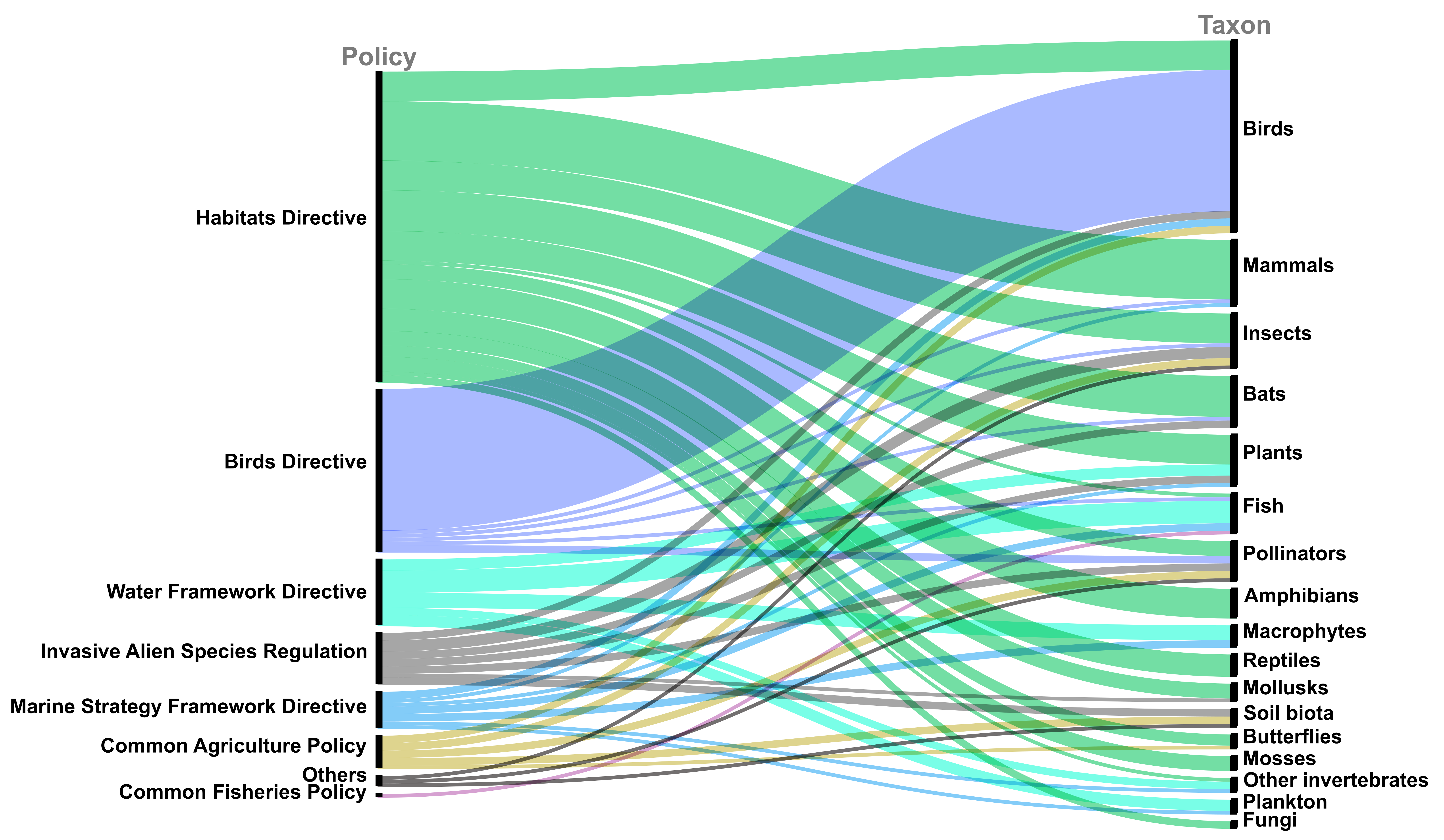
Policy Brief #37, March 2023. Increasing the policy impact and effectiveness of biodiversity monitoring in Europe: current state and gaps.
Current biodiversity monitoring in Europe is fragmented and often inconsistent across countries. Monitoring efforts face multiple challenges including insufficient technical and human capacity, limited funding, data unavailability, and lack of long-term policy support.
To address these challenges, the Europa Biodiversity Observation Network (EuropaBON) proposes five clusters of solutions to improve the collection and uptake of policy-relevant biodiversity data:
- Enhance coordination and collaboration of monitoring efforts by identifying priorities, using standardized protocols, and aligning reporting requirements with specific indicators.
- Increase data standardization through the combination of Essential Biodiversity and Essential Ecosystem Services Variables (EBVs and EESVs) with dedicated data sharing and exchange mechanisms that adhere to open and FAIR (findable, accessible, interoperable, and reusable) principles.
- Leverage modeling efforts and new technologies to integrate with traditional monitoring methods.
- Enable additional, consistent, and long-term financial resources for monitoring efforts, including more and better coordination across countries, institutions, and sectors, along with privatesector investments.
- Expand, adapt, and deliver capacity building, such as expert training, creating new exchange knowledge platforms, and embracing citizen science initiatives.
We propose the creation of a European Biodiversity Monitoring Coordination Centre in the near future to implement lasting improvements in the collection, analysis, reporting, and political uptake of biodiversity data in all European countries.
Biodiversity data needs of users and policymakers
Two main clusters of user and policy needs are of key importance in Europe over the next 5-10 years:
- Biodiversity data are needed to ensure the design of integrated cross-sectoral policies. They can provide evidence for policies on agriculture, climate change, infrastructure, freshwater, marine spatial planning, fisheries, and nature-health linkages.
- Biodiversity data are needed to increase policy impact and effectiveness to fulfill the goals of the EU Biodiversity Strategy. Enhanced biodiversity monitoring can inform and guide policy targets on conservation, marine biodiversity, restoration, ecosystem services, tele-coupling1, and societal engagement.
1 Ecological footprint in other countries.
Current monitoring schemes in Europe show biases in taxa and ecosystems
Current monitoring schemes in Europe mainly focus on a subset of species and protected areas, with habitats and ecosystems covered to a lesser extent, and genetic diversity even more rarely monitored. The most intensively monitored taxonomic groups are birds, mammals, and vascular plants. However, with exceptions such as some bird species and some priority habitat types, monitoring schemes do not cover the full range of genetic, taxonomic, and ecosystem diversity within member countries. The coverage of species is biased, as many of the national monitoring activities are mainly influenced by the reporting obligations of the Birds and Habitats Directives (Fig. 1).
However, the situation is more positive on the aquatic side, due to the Water Framework Directive (WFD), for which all European countries established both surveillance and operational monitoring programs following its monitoring guidance, standardized sampling, and analysis methods. They also intercalibrated their assessment methods, thus rendering the data more comparable across countries. However, the WFD’s potential to deliver biodiversity data could be enhanced by making the raw data collected widely available.
Figure 1: Alluvial diagram showing the flow of monitoring data collected for various Taxon to the key EU Biodiversity Directives and Policies. Please note that some smaller taxonomic groupings may also be included in larger taxonomic groupings identified by the users during the assessment process, which the groupings in this figure are based on. Thickness of the lines represents the number of monitoring schemes
focusing on the respective Taxon, as determined from survey responses.
Monitoring faces many challenges
The EuropaBON project assessed how biodiversity data inform and trigger policy action in Europe, as well as related challenges that EU countries and relevant agencies face. We found that most roadblocks to monitoring by national agencies can be attributed to a chronic lack of predictable, long-term funding. Other, partly secondary, roadblocks include a lack of support to establish integrated, coordinated monitoring programs and insufficient technical capacity. Biodiversity monitoring also suffers from a lack of guidance in identifying monitoring priorities; a lack of authoritative and standardized monitoring protocols; reluctance to adapt existing monitoring practices; the unavailability of data from sectors such as agriculture, fisheries, and energy; and limited in-house knowledge and technical infrastructure to adequately mobilize, access, and analyze biodiversity data. Additionally, insufficient georeferenced biodiversity information is severely hindering the assessments of biodiversity and ecosystem trends over time, as well as infrastructure planning (e.g., detailed geo-referenced data on protected species potentially influences the constructions of dams or roads). This is partly because agencies often only have access to regionally aggregated assessments of species or ecosystems but the underlying specific (raw) data are not traceable or easily accessible.
Proposed solutions to improve biodiversity monitoring
The following five solutions are proposed as potential avenues to address the challenges (Fig. 2):
- Improve the coordination, cooperation, integration, and synchronization of monitoring efforts. This is key to synthesizing Europe’s fragmented biodiversity data landscape. Coordinated programs need to identify monitoring priorities as well as standardized, efficient, and agreed-upon monitoring protocols. Increased spatial, temporal, and taxonomic homogenization of data collection, along with improved cross-country monitoring coordination and integration (ideally through a European coordination platform) will improve the effectiveness and impact of current monitoring efforts. Reporting obligations must be coordinated and provide clearly defined indicators for each (new) policy target, so that cross-country comparison is possible.
- Enhance data gathering, standardization, mobilization, and sharing mechanisms. Strengthening the principles of open and FAIR data, creating public databases, and new statistical tools for integrating heterogeneous data, will make data more accessible to both researchers and policymakers. Essential Biodiversity Variables (EBVs) and Essential Ecosystem Service Variables (EESVs) can be used as frameworks to standardize and coordinate biodiversity data collection and monitoring. Data collected by private companies for environmental impact assessments could be made available through online open repositories, along with raw data collected under the Nature Directives. Overall, open access should acknowledge the data providers, and donor institutions should be evaluated by the impact of the monitoring they are funding.
- Increase modeling efforts and the use of new technologies. Both will serve as important solutions to address monitoring design, methods, data analysis, and uptake, and have great potential to standardize in-situ biodiversity monitoring in Europe. New technologies and scientific advancements include artificial intelligence, 24/7 automatic monitoring, biologgers, remote sensing, and Environmental DNA (eDNA) based on metabarcoding or shotgun sequencing. Models should be increasingly used to develop policy support tools, and the role and potential of modeling should be enhanced among decision-makers.
- Ensure sufficient financial resources. Sufficient and predictable funding can address the lack of capacities in member states, foster the integration of data and monitoring schemes, and maintain the long-term viability of monitoring efforts. Long-term, cross-country, cross-institutional, and cross-sectoral coordination of funding, along with private sector investments and adequate recognition of biodiversity monitoring funding needs across sectors, can help unlock and mobilize financial resources.
- Build capacity to harness and develop a network of skills, knowledge, and people. Key solutions include training experts across all disciplines, working with existing and creating new biodiversity platforms in collaboration with the Knowledge Centre for Biodiversity, fostering extensive networks for experts and stakeholders to share ideas and exchange knowledge, and embracing citizen science as a means of involving volunteers in monitoring and designing an effective, user-driven monitoring scheme for Europe.
To achieve this vision of supporting evidence-based decision-making through robust biodiversity monitoring data, we recommend the creation of a European Biodiversity Monitoring Coordination Center (BMCC). The BMCC can address the above-mentioned challenges and implement the proposed solutions. Such a European-wide coordination center is currently being co-designed by a wide range of stakeholders led by EuropaBON and Biodiversa+ and should be operational in the next two years. This center will be key to harnessing Europe’s rich, yet fragmented data landscape to answer urgent questions for policy, practice, and research.
About the project
EuropaBON is working with stakeholders to co-design an EU-wide system to monitor biodiversity and ecosystem services and to investigate the feasibility of setting up a center to coordinate monitoring activities across Europe. The project engages users at the local, regional, and European level to identify the data needs of policies and targets aligned with the new European Green Deal and the Biodiversity Strategy for 2030.
The project receives funding from the European Union’s Horizon 2020 research and innovation program under grant agreement No 101003553.
Acknowledgments
We gratefully acknowledge the expertise and time of hundreds of colleagues from policy, practice, and research who have participated in EuropaBON workshops and contributed their insights and knowledge through interviews, surveys, and document reviews. They include experts from the European Commission and ministries of EU and non-EU Member States, as well as from non-governmental organizations, natural history societies, museums, and research institutes. Their insights and expertise form the basis for this policy brief.
List of authors
Hannah Moersberger, Juliette G. C. Martin, Jose Valdez, Jessica Junker, Ivelina Georgieva, Silke Bauer, Pedro Beja, Tom Breeze, Lluís Brotons, Helge Bruelheide, Nestor Fernández, Miguel Fernandez, Ute Jandt, Christian Langer, Anne Lyche Solheim, Joachim Maes, Francisco Moreira, Guy Pe’er, Joana Santana, Judy Shamoun-Baranes, Bruno Smets, Ian McCallum, Henrique M. Pereira, Aletta Bonn
Recent project-related publications
Moersberger, H., Martin, J.G.C. , Junker, J., Georgieva, I. , Bauer, S., Beja, P., Breeze, T., Brotons, L., Bruelheide, H., Fernández, N., Fernandez, M., Jandt, U., Langer, C., Lyche Solheim, A., Maes, J., Moreira, F., Pe'er, G., Santana, J., Shamoun-Baranes, J., Smets, B., Valdez, J., McCallum, I. , Pereira, H.M., & Bonn, A. (2022). Europa Biodiversity Observation Network: User and Policy Needs Assessment. EuropaBON/German Centre of Biodiversity Research (iDiv) , Leipzig. 10.3897/arphapreprints.e84517.


